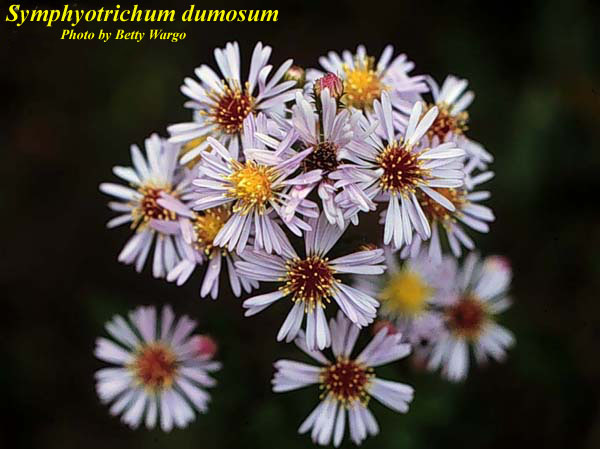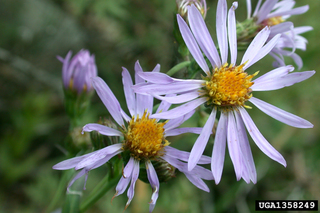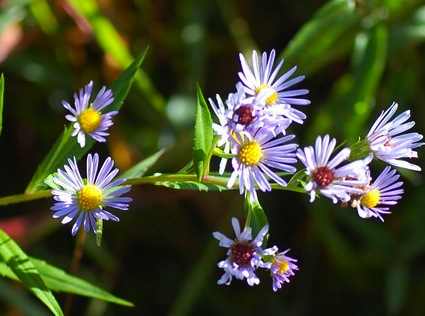The New England Aster and Related Species
By Joe Francis, Fairfax Master Gardener
Aster is a genus of flowering plants in the family Asteraceae. It is a very large family, and some taxonomic order on size control corralled this genus by geographic locations of its group species. The big winner and keeper of the name Aster went to some 180 species located in Eurasia. All good rules have exceptions, and the native species Aster alpinus spp. vierhapperi, found in North America, continues its listing in Asteraceae. It produces single stem inflorescences, can withstand -18.6F and needs 90 frost free days to flower with a strong preference for cool temperatures.
The other Aster subspecies found in North America were determined by morphologic and molecular research to be reclassified out of the Aster genus. They remain within the tribe Astereae. This sorting reclassified this group of eight asters into changed genera. The New England Aster, novae-angliae, and seven other Aster species are now catalogued in the genera Symphyotrichum.
The transferred genera Symphyotrichum lists these species briefly described as follows:
Symphyotrichum cordifolium, blue wood aster, is 3 feet to 5 feet and faded blue to rich blue with yellow centers. Pinch several times before mid-July to tame height. A tough plant.

Symphyotrichum dumosum
Symphyotrichum ericoides, white heath aster, is 1 foot to 3 feet. Its leaves are sessile (stalk-less) and narrow. There are two varieties, v. ericiodes that spreads by underground rhizomes [invasive alert], and v. pansum, whose roots remain in the typical clump with corm-like caudices. It is generally considered to be a tough plant but is subjected to fungal infections if not planted in open, sunny locations.

Symphyotrichum laeve
Symphyotrichum lateriflorum, Lady in Black, is a maroon blue flower. Any time spent researching this cultivar will be time well spent. It tops out at 3 feet without pinching. Pinching will simply make a very floriferous presentation even more robust. There is an extensive line of miniature clones developed in this species attaining 12 inches to 18 inches in height.

Symphyotrichum novae-angliae
Symphyotrichum novi-belgii (New Belgium), common name New York aster, was registered when New York was called New Belgium. It is an outstanding pink cultivar with very bushy flowers.

Symphyotrichum_novi-belgii
Symphyotrichum pilosum v. pilosum, is the hairy white oldfield aster or frost aster. It is not inclined to branch freely and blooms appear on its upright stem structure. It grows from 1 foot to 5 feet and thrives in part shade to full sun. In comparison to the preceding series discussed, the flower count would be considered low.
I was unable to find any consolidated listing of the primary cross and subsequent progeny activity of any of the listed species. However, references made to offspring crosses that tamed height and increased the color palette found in the retail literature suggest plant breeders worked diligently to overcome the height traits found in the pure species plant stock.
This is a gardener’s dream come true for the end of the garden season color requirement that takes one to the cusp of the first killing frost. Added bonuses are their attraction to migrant butterflies and to bee pollinators in search of nourishment to make it to their next stop. Careful attention to cultivar selection can provide solid color in the mid-September to late-October growing period. Large quantities of flowers translate to copious seed dispersal, and preemptive dead heading is an option.
Culture concerns are quite flexible. Plants grow in zones 1 to 8 and really thrive in zones 3 to 8. They for the most part require full sun and considerable air circulation. They tolerate all types of soil conditions and a pH range of 6.4 to 7.5 is fine. Their defining “fault” is, as the plant moves through its growth cycle, the lower leaves become untidy. This can be overcome by pruning new growth in early June to about 6 inches high. This goes a long way in taming height challenges. Also, return in early July and prune the outer circle of plant stems by 25 percent. The effect of this selective pruning will be an outer ring of stem flower growth that will mask the lower leaf loss on the higher blooming stems. Pruning after mid-July will delay the fall blooms by two weeks, and you will be provided with reduced flower output. Other than the fungal challenges on the lower stem and the presence of powdery mildew if in a very poor air circulation environment, the usual garden pests take a pass.
The Symphyotrichum genera benefit wildly if lifted and divided each spring in alternate years. The plants’ rejuvenation following this lift and divide will be quite noticeable. These plants usually end up in the back row of the perennial garden. Their placement helps define the borders and provides lasting color in the cool, fall season during the waning days of the active growing season.
Resources
New England Aster, Missouri Botanical Garden, (also search other species at this site)
New York Aster, University of Maryland Extension
The Well-Tended Perennial Garden, 2nd Edition, by Tracy DiSabato-Aust
(Use search engine using the species name to find retail stock availability)